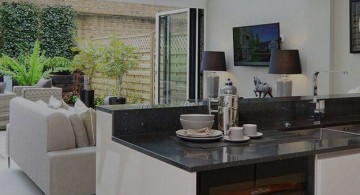
8 Ways to Instantly Make a Room Look Far More Spacious

Most of the time, a spacious environment is more relaxing and enjoyable to be inside. Instead of feeling cramped in a confined space, your senses can breathe as you’re able to move around and absorb the sense of freedom.
Short of moving to another property or conducting a refurbishment or residential construction, there’s little you can do to increase the actual floor space of a bedroom, living room or bathroom. However, there are a number of quick and very simple tricks which can increase the perceived space and ultimately make the room feel larger than it really is.
Let’s take a look at a few of them:
1). Increase natural light
A brighter room will always feel more spacious and airy compared to one which is dark and gloomy. For that reason, try to increase natural light flow by installing larger windows or glass doors. If this is too much of a task, then try removing heavy curtains or blinds and also removing any windowsill clutter which could impede light flow. The more light, the better!
2). Increase empty floor space
More empty floor space contributes towards an open plan feel, so try to have at least one section of empty space where you could comfortably stand without being impeded by any objects around you. To achieve this, try removing tables (or using a smaller table) and also removing any rugs.
3). Use bright tones on walls and other surfaces
Bright tones reflect more light and ultimately make the room feel more spacious. Whites and creams work well for this – even if they’re paired with darker undertones to provide contrast.
4).Use mirrors
As mirrors reflect the area back on themselves, it helps to increase the perceived space without actually increasing room size – almost like a visual portal to another section of the room. Try and place large mirrors on walls and also near windows to get in more of that natural light. Also avoid pointing mirrors towards cluttered areas as this can increase the perceived clutter and ultimately makes the room feel more cramped.
5). De-clutter
Store away any items which aren’t regularly used to increase the overall empty volume within a room. You could also try de-clutting fixtures, fittings and decorations through experimentation. For example, remove a pillow or two from a sofa, or remove a decorative fixture from a wall, and then see if it helps to make the room feel more spacious.
6). Push things back
One very simple yet understated trick! Make sure any items of furniture are pushed right up against any walls. Sometimes they can be an inch or two away, so by pushing them back, you can free up a few inches of floor space throughout the whole room and then increase the perceived area. A few places to check include sofas and also TVs placed in corners.
7). Improve room flow
Walk throughout you room to see how well people can flow through as they move around. If you have to move through any narrow areas where you may risk knocking a piece of furniture, then this can create a bottleneck which can reduce the perception of space. If this happens, try adjusting items of furniture so you have plenty of space to manoeuvre around.
8). Experiment with layout
There’s no hard and fast rule when it comes to spacious layouts, so it’s always best to experiment to see what works. You may not only happen upon a far more spacious layout by chance, but freshening up the layout can really bring back an extra boost of enthusiasm for your design and that post-decoration excitement – especially if you’ve had the old layout for years. When experimenting with layout, try placing seating areas near windows, making sure that the view when seated is clutter-free, and also leaving plenty of central floor space for that ‘open plan’ feel.


Leave a Reply
Be the First to Comment!